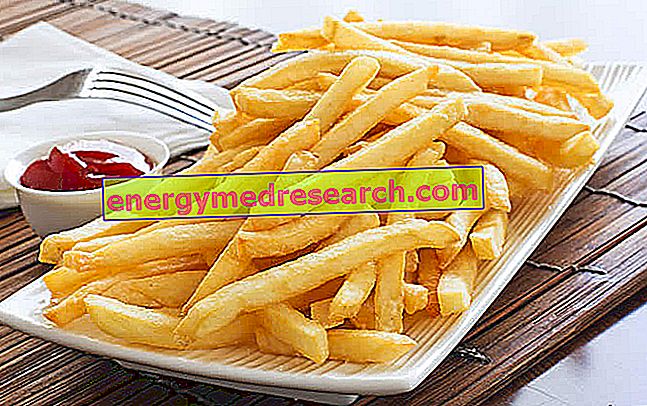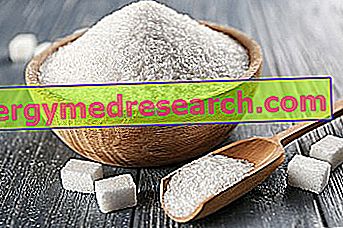Generality and Definition
French fries are foods of vegetable origin based on tubers of the species Solanum tuberosum, properly cleaned, cut into pieces and cooked in a boiling fat (usually a vegetable oil, more rarely an animal fat).

French fries are one of the so-called fast food (fast food). Furthermore, they are fully included in the category of junk food (junk food); this rather disparaging classification is justifiable by the nutritional characteristics and the nutritional role that fried potatoes play in the western diet; below we will better understand why.
French fries should be included in the group of side dishes, even if in fact a portion (200-250g) satisfies for 1/4 or 1/5 of the total energy required by an adult organism, therefore roughly twice or triple compared to a side dish of vegetables.
French fries in a bag (like chips) are part of the whole of snacks and are used mainly in snacks. Compared to those freshly fried, they are even more caloric and a portion (30g) has about 50% more energy than is required for a secondary snack (estimated on a 2000kcal / day diet).
Nutritional Features
As anticipated, all types of fried potatoes should be considered "junk food".
This statement does not depend so much on the excess caloric content of these foods (an aspect that could easily be compensated for by smaller portions), as well as by the chemical profile and the levels of contamination.
All fried potatoes are high energy foods, with a prevalence of carbohydrates for fresh ones and lipids for those in bags, followed by proteins. The chips in the bag are much more caloric, because the portion of fat is greater and that of water is lower.
The quality of fatty acids depends above all on the ingredient used for frying. It is therefore essential to specify that the tendency of restaurateurs and of the food industries foresees the choice of the most economical product and with the greatest resistance to high temperatures; usually palm or palm kernel is favored. Much more rarely (and certainly at a greater cost) it is possible to find fresh potatoes fried in peanut oil or extra virgin olive oil. Normally, both fresh and packaged fried potatoes are characterized by a prevalence of saturated fatty acids and by the significant presence of those in trans conformation.
The carbohydrates of fresh chips and those in bags are almost exclusively complex, that is "starch". Proteins, on the other hand, tend to have a medium biological value.
If not cooked in animal fats, fried potatoes do not contain cholesterol and the amount of dietary fiber seems satisfactory.
From the saline point of view, both types of fried potatoes show a good level of potassium and an appreciable (but not high) quantity of iron. For fresh fried potatoes without added salt, the sodium intake is normal; on the contrary, those in envelopes have an excessive dose. Regarding vitamins, a good concentration of ascorbic acid (vit. C) and thiamine (vit B1) is observed; for chips in bags also niacin (vit PP) does not disappoint.
NB . In fries in a bag all the nutrients, including lipids and calories, are more concentrated due to the lack of water in the food.
Perfect French Fries - All the Secrets to Frying them at Home
X Problems with video playback? Reload from YouTube Go to Video Page Go to Video Recipes Section Watch the video on youtubeFrench fries are poorly digestible, therefore unsuitable for feeding against gastritis, ulcers, gastro esophageal reflux and some gall bladder impairments; moreover, due to certain residues of the Maillard reaction, fried potatoes can increase the risk of certain diseases of the stomach and intestines. In the next paragraph we will understand better why.
Even evaluating only the nutritional parameters, it is immediately evident that any fried potato is not a food suitable for the nutrition of the overweight person. Moreover, if cooked in vegetable oil with a high percentage of saturated fats (bifractionated, hydrogenated, etc.), or in animal fat (beef tallow or lard), they must absolutely not be part of the diet of those suffering from hypercholesterolemia. Due to the high glycemic load, fried potatoes should also be avoided by those suffering from hyperglycaemia (or overt type 2 diabetes mellitus) and hypertriglyceridemia. Those in the envelope, due to the surplus in sodium, must be eliminated from the hypertension diet.
Ultimately, fried potatoes are completely unsuited to the clinical nutrition of metabolic disorders.
All fried potatoes can be a vegetarian or vegan food (except for the use of lard or beef tallow), and they have no contraindications for gluten and lactose intolerance.
The average portion of fresh chips is about 100-150g (190-280kcal); of those in envelopes about 15-30g (75-150g).
Nutritional Composition for 100g of "Potatoes, Cooked Potatoes, Fries, Salted" and "French Fries, In Bag"
| Chemical composition | Value for 100g of Potatoes, Cooked, Fried, Uncooked | Value for 100g of French Fries, In Bag | |
| Edible part | 100% | 100% | |
| water | 55, 5g | 12, 1g | |
| Protein | 3, 9g | 5, 4g | |
| Total lipids | 6, 7g | 29, 6g | |
| Saturated fatty acids | - g | - g | |
| Monounsaturated fatty acids | - g | - g | |
| Polyunsaturated fatty acids | - g | - g | |
| Cholesterol | 0, 0mg | 0, 0mg | |
| Carbohydrates available | 29, 9g | 58, 5g | |
| Starch | 26, 6g | 51, 8g | |
| Soluble sugars | 0.6g | 1.0g | |
| Total fiber | 2.2 g | - g | |
| Soluble fiber | - g | - g | |
| Insoluble fiber | - g | - g | |
| Phytic acid | 0.0g | 0.0g | |
| Alcohol | 0.52g | 0.52g | |
| Power | 188, 0kcal | 507, 0kcal | |
| Sodium | 12, 0mg | 1070, 0mg | |
| Potassium | 660, 0mg | 1060, 0mg | |
| Iron | 0, 8mg | 1, 8mg | |
| Football | 11, 0mg | 28, 0mg | |
| Phosphorus | 62, 0mg | 158, 0mg | |
| Magnesium | - mg | - mg | |
| Zinc | - mg | - mg | |
| Copper | - mg | - mg | |
| Selenium | - µg | - µg | |
| Thiamine | 0, 24mg | 0, 11mg | |
| Riboflavin | 0, 02mg | 0, 07mg | |
| Niacin | 0, 70mg | 4, 60mg | |
| Vitamin A retinol eq. | tr | 0, 0μg | |
| C vitamin | 9, 0mg | 27, 0mg | |
| Vitamin E | - mg | - mg | |
Carcinogenic fried potatoes
Because of their heat treatment at very high temperatures, fried potatoes (both fresh and in bags) contain various molecules that tend to be harmful to health. Some of these have only a negative effect on the metabolism, such as fatty acids in trans conformation (already abundant in certain refined oils), while others are real poisons; below we will describe the most important ones.
Acrylamide : It is the result of the carbonization of carbohydrates and represents an unwanted product of the Maillard reaction. French fries are considered the most abundant food source of acrylamide. According to the "American Cancer Society" there are serious possibilities that the excessive presence of acrylamide in food may seriously predispose to the formation of cancer (stomach, small intestine, colon, etc.).
Formaldehyde and Acrolein : They are the result of the overcoming of the point of smoke of the oil (which also correlates also to the production of acrylamide), more precisely of the thermal alteration of the glycerol which structures fatty acids. They are incredibly toxic to the liver and, being also volatile, are also harmful to the eyes and the respiratory tract.
Aromatic Polycyclic Hydrocarbons : These are obtained by degeneration of the amino acids. French fries are not rich in proteins but not even free; in fact, the sulfur and heterocyclic amino acids that structure them tend to change at temperatures> 200 ° C. These compounds are also suspected of a certain carcinogenic action.
For more information on the correct frying technique, useful for limiting the formation of these harmful compounds, see the dedicated article by clicking here.



